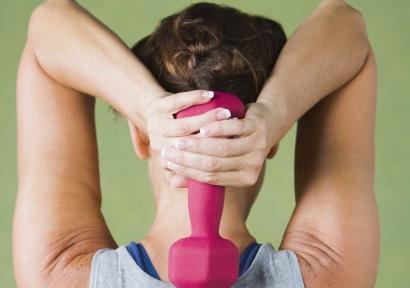
If raising your arm above or behind your head triggers a stabbing or shocklike pain in your shoulder area, you could have rotator cuff tendinitis. “The pain worsens with activity and could even wake you from sleep,” says William Levine, MD, director of the sports medicine department of orthopedic surgery at Columbia University Medical Center. Though younger adults can develop it, it’s estimated that more than half of people over age 65 will have rotator cuff pain.
Why it happens
Lifting your arms over your head—when painting walls, for example, or playing tennis—puts you at risk. Sleeping with your arm over your head and carrying heavy bags on your shoulder can also cause rotator cuff problems. Mild cases can improve within weeks, but it may take months for people with severe pain to feel better. “Don’t lift your arm repeatedly until things settle down,” advises orthopedist Eric Ricchetti, MD, of the Cleveland Clinic.
Short for transcutaneous electrical nerve stimulation, TENS uses electrodes to deliver a pulsed electrical current—imagine a pins-and-needles sensation—to the shoulder. “TENS stimulates nerve endings so your brain doesn’t perceive the pain,” says Gary Calabrese, a physical therapist at the Cleveland Clinic. TENS may also release pain-easing chemicals called endorphins. The treatment doesn’t quell inflammation, but it “can help you exercise a little more efficiently,” says Calabrese.
New: Ultrasound/ heat
Heat increases blood flow to tissue, easing inflammation and speeding healing. It also improves flexibility and relaxes muscle spasms so it’s easier to do the exercises that improve your shoulder’s range of motion and strength. “Ultrasound warms up tissue pretty deeply and quickly,” says Calabrese. Your therapist might also apply a moist heating pad to your shoulder for 15 to 20 minutes before exercise; you can do this at home as well.
New: Ice
Use the cold stuff at the very first twinge to lessen inflammation, decrease swelling, and reduce pain, advises Calabrese. Apply ice for 12 to 15 minutes every other hour, using an ice pack, a bag of frozen peas, or an ice-filled plastic bag. (Cover skin with a towel to prevent frostbite if you use a bag.) As the pain subsides, apply ice three times a day until you’re completely pain-free.
Natural: Acupuncture
In one study, 52 athletes with rotator cuff pain got biweekly acupuncture treatments for 4 weeks, which slashed their pain by 50%. “Qi [energy] or blood flow blockages cause pain,” says David Kato, the owner of Lincoln Square Acupuncture in Chicago. “Acupuncture can free these blockages and improve your circulation so that inflammation and pain lessen (in addition to these other science-backed benefits).”
Natural: Stretching
Rotator cuff tendinitis causes shoulder stiffness, so improving range of motion with stretches that target the shoulder muscles is crucial. Calabrese has patients perform 50 daily reps of exercises, including the pendulum, in which you bend over and let your affected arm dangle as you make circles with it. He also recommends the wall slide: Run the hand on your injured side up and down a wall as though you’re washing the wall.
Natural: Yoga
An easy yoga pose can reduce pain by 90%, says Loren M. Fishman, MD, an assistant professor of physical medicine and rehabilitation at Columbia University Medical Center. Interlock your fingers and press your palms together, then place your hands and forearms against a wall, forming a triangle. Rest the top of your skull against the wall in the center of the triangle. Walk your feet about 24 inches away from the wall. Lower your chest and press your elbows and forearms into the wall. Pull your shoulders back, down, and away. Hold for 45 seconds or so. Stand up straight. Lift your affected arm sideways above your head and then (still lifted) in front of you. Try this pose daily for 2 to 3 weeks. (Also consider these 5 pain-relieving yoga poses.)
Tried & True: Cortisone shots
If other therapies fail, your doctor may try a cortisone injection. If the shot provides long-lasting relief, it may be worth getting another in the future. However, if the effects wear off quickly, “it’s probably not worth repeating,” says Dr. Ricchetti. Your doctor will limit the injections to three or four in a shoulder per year. More frequent cortisone injections may have negative side effects, such as weakening of the rotator cuff tendons or the cartilage in the shoulder joint.
Tried & True: Surgery
If you’ve tried other therapies for 6 months and still hurt, consider surgery, advises Dr. Levine. Surgery involves removing any bone spurs and the inflamed bursa. Sometimes the surgeon finds and repairs a tendon tear. The outpatient surgery, done under anesthesia, lasts up to 2 hours. Rehab can start immediately, with recovery taking from 2 to 6 weeks. Rehab following a tear repair may not begin for 2 to 6 weeks; recovery can take 6 to 12 months.
Tried & True: Strengthening
When you can’t use your shoulders, muscles weaken. Once range of motion improves, Calabrese has patients strengthen their rotator cuff muscles starting with 1-pound dumbbells and slowly increasing to 5 pounds. “Low weights and high reps let people adapt to the weight without stressing tendons or muscles,” he says. Exercise Rx: up to 50 reps of three to five exercises, spread throughout the day. “The more you work your muscles, the stronger your shoulder will get,” Calabrese explains.
Source: prevention
 We are sharing information for knowledge. Presented by. SocialDiary.Net
We are sharing information for knowledge. Presented by. SocialDiary.Net



